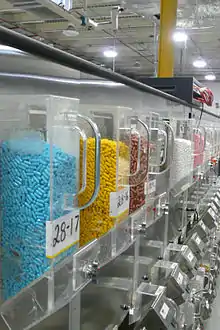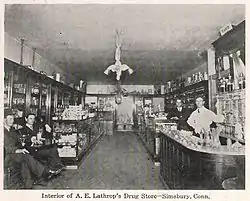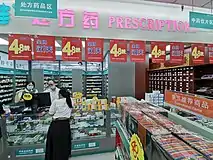Pharmacy (shop)
A pharmacy (also called drugstore in American English or community pharmacy or chemist in Commonwealth English) is a retail shop which provides pharmaceutical drugs, among other products. At the pharmacy, a pharmacist oversees the fulfillment of medical prescriptions and is available to counsel patients about prescription and over-the-counter drugs or about health problems and wellness issues. A typical pharmacy would be in the commercial area of a community.

Dispensing or compounding
Most drugs are commercially made at factories and dispensed by pharmacies. Drugs that are not commercially made must be compounded from other ingredients. In 1930, 75% of medications were compounded, but by 1970 only 1% were compounded.[1]
Community pharmacies (drugstores)
In most countries, a retail outlet for prescription drugs is subject to legislation; with requirements for storage conditions, staff qualifications, equipment, record keeping (especially of controlled drugs) and other matters, all specified in legislation. It was once the case that pharmacists stayed within the premises compounding/dispensing medications, but there has been an increasing trend towards the use of trained pharmacy technicians, with the pharmacist spending more time communicating with patients. Pharmacy technicians are now more dependent upon automation to assist them in their new role dealing with patients' prescriptions and patient safety issues.
Pharmacies are typically required to have a qualified pharmacist on-duty at all times when they are open. It is also often a requirement for the owner of a pharmacy to be a registered pharmacist, but that is not the case in all jurisdictions: where permitted, many retailers (including supermarkets and mass merchandisers) now include a pharmacy as a department of their store.

Likewise, many pharmacies are now rather grocery store-like in their design. In addition to medicines and prescriptions, many now sell a diverse arrangement of additional items such as cosmetics, shampoo, office supplies, confections, electronics, home decor, snack foods, durable medical equipment, greeting cards, and provide photo processing services.
Community pharmacies offer a unique added value by building direct relationships with their customers. They are able to provide more personalized, dedicated care to local members of their community and even offer enhanced services such as Medication Therapy Management (MTM), Medication Synchronization, and compounding. With the aid of pharmacy management systems and different integrated technologies, these smaller pharmacies are able to keep up with their large-scale competition.
Ethical standards
Community pharmacists’ understanding of ethics, confidentiality, patient autonomy, trustworthiness and reliability are essential in community practice and must influence their decision making should an ethical dilemma arise. In some countries, community pharmacists may be asked to compromise on their values and ethical issues may arise not only because of patient's or physician's request but may also because of their employers' intrusion. Individual factors such as age, gender, work experience, and educational level and organizational factors such as the number of pharmacists in a pharmacy and location of pharmacy may affect the ethical perspectives of community pharmacists.
Characteristics of a good pharmacy
The American Association of Colleges of Pharmacy recommends that consumers choose a pharmacy at which they can have a consulting relationship with the pharmacist.[2] Anyone using drugs benefits when they have easier access to a pharmacist. Being timely includes both processing the request quickly and having drug stock available to fill the prescription.[2] Some consumers need drugs delivered to their home, perhaps by mail, and may select a pharmacy that offers that service.[2] Different pharmacies may charge different prices for the same drugs, so shopping for lower prices may identify a pharmacy offering better value.[2] In addition to fulfilling prescriptions, a pharmacy might offer preventive healthcare services like vaccinations.[2] Up-to-date technology at a pharmacy can assist a patient with prescription reminders and alerts about potential negative drug interactions, thereby reducing medical errors.[2]
Duties of pharmacy staff
The International Pharmaceutical Federation has declared their vision of a community-based pharmacist:[3]
- An expert in pharmaceutical care, pharmacotherapy and health promotion
- A professional communicator with patients, other healthcare providers and decision makers
- Deliver high quality products, services and communication
- Document their work and communicate the outcome to professional colleagues.
Responsibilities
Community-based pharmacists' responsibilities include: checking and dispensing of prescription drugs, providing advice on drug selection and usage to doctors and other health professionals and counseling patients in health promotion, disease prevention and the proper use of medicines.[4]
In most countries regulations govern how dispensaries may operate, with specific requirements for storage conditions, equipment and record keeping.
United Kingdom
It is becoming more common for pharmacists to take on extended roles that provide more clinical care directly to patients as part of a primary care team. There are around 11,400 community pharmacies in England. Many are open for extended hours in the evenings and weekends and they are accessible without appointment.[5][6]
In the English NHS there were 438 million visits nationally to community pharmacies for health related reasons in 2015. More than 1 billion prescription items were dispensed in 2012. More than £14 billion is spent on prescribed drugs annually.[7] Under the 2005 NHS Community Pharmacy contract all community pharmacists in England and Wales provide:[8]
- Dispensing Service
- Repeat Dispensing Service: This allows the patient to collect regular repeat prescription medicines for an agreed period of time, without having to go back to their GP
- Disposal of Unwanted Medicines.
- Promotion of Healthy Lifestyles.
- Signposting to other Services.
- Support for Self-Care: advice on treating minor illnesses and long term conditions.
Widely available Advanced Services:
- Medicines Use Review & Prescription Intervention.
- New Medicine Service. For patients who have been given their first prescription for a medicine to treat Asthma and COPD, Type 2 diabetes, Hypertension or Anticoagulant Therapy.
- Appliance Use Review Service.
- Flu Vaccination.
Enhanced Services which are not available unless locally commissioned:
- Minimising Adverse Effects and Admissions Related to Medicines.
- Discharge and Transfer Planning.
- Managing Dental Pain.
The introduction of the digital hospital-to-pharmacy referral service, which was to launch in July 2020, as part of the new community pharmacy contract, was postponed to 15 February 2021 because of the COVID-19 pandemic in England. It will enable hospitals to digitally notify community pharmacies when patients are discharged and may need advice on taking new medicines, and about changes to their prescriptions.[9]
In 2022 the average pharmacy carried out around 19 consultations per day, averaging 5.6 minutes each - about 65 million consultations across 10,800 pharmacies in the year. [10]
Support staff
To help pharmacists be able to take on extended roles, it is common for them to work as part of a team that can include pharmacy technicians, dispensing assistants and counter assistants.[11]
Ownership
In parts of mainland Europe, the pharmacist is required to own the pharmacy of which she or he is the licensee. Under this arrangement, a pharmacist can be the operator of only a single outlet.[12] In the UK, 60% of all community pharmacies are owned by companies that own multiple pharmacies.[13]
In the United States, more than 25% of independent owners have ownership in two or more pharmacies.[14]
Most of New Zealand's community pharmacies are owner-operated.[15] In Australia, pharmacists recognise the need to integrate professional pharmacy services into the health system to meet the changing health care needs of the population.[16]
Society and culture
A survey conducted by PrescribeWellness found that almost half of Americans older than 40 years-old value pharmacies that offer preventative care services, and would be willing to transfer their prescriptions to pharmacies that offer those services.[17] Patients also value pharmacies where they can receive medical advice concerning their prescription medications, how those medications may interact with each other, and receive over-the-counter drug recommendations for the management of common ailments.[17] In a survey of over 1,000 U.S. adults older than 40 years-old conducted by Propeller Insights, 67% of patients responded that they would prefer that their pharmacist discuss new prescriptions with them, rather than their physician, because they viewed their pharmacist as "better at explaining side effects and has more time to spend with them."[17]
Internet pharmacies

Since about the year 2000, a growing number of Internet pharmacies have been established worldwide. Many of these pharmacies are similar to community pharmacies, and in fact, many of them are actually operated by brick-and-mortar community pharmacies that serve consumers online and those that walk in their door. The primary difference is the method by which the medications are requested and received. Some customers consider this to be more convenient and private method rather than traveling to a community drugstore where another customer might overhear about the drugs that they take. Internet pharmacies (also known as online pharmacies) are also recommended to some patients by their physicians if they are home-bound.
While most Internet pharmacies sell prescription drugs and require a valid prescription, some Internet pharmacies sell prescription drugs without requiring a prescription. Some customers order drugs from such pharmacies to avoid the "inconvenience" of visiting a doctor, or to obtain medications which their doctors were unwilling to prescribe. However, this practice has been criticized as potentially dangerous, especially by those who feel that only doctors can reliably assess contraindications, risk/benefit ratios, and an individual's overall suitability for use of medication. There also have been reports of such pharmacies dispensing substandard products.[18]
Of particular concern with Internet pharmacies is the ease with which people, youth in particular, can obtain controlled substances (e.g., Vicodin, generically known as hydrocodone) via the Internet without a prescription issued by a doctor/practitioner who has an established doctor-patient relationship. There are instances where a practitioner issues a prescription, brokered by an Internet server, for a controlled substance to a "patient" s/he has never met. In the United States, in order for a prescription for a controlled substance to be valid, it must be issued for a legitimate medical purpose by a licensed practitioner acting in the course of legitimate doctor-patient relationship. The filling pharmacy has a corresponding responsibility to ensure that the prescription is valid. Often, individual state laws outline what defines a valid patient-doctor relationship. The Food and Drug Administration (FDA) is also heavily involved in monitoring internet pharmacies and has issued warnings against several companies who have violated the U.S. Federal Food, Drug, and Cosmetic Act that protects individuals against rogue online pharmacies.
Canada is home to dozens of licensed Internet pharmacies, many of which sell their lower-cost prescription drugs to U.S. consumers (who must otherwise pay one of the world's highest drug prices).[19] In recent years, many consumers in the US (and in other countries with high drug costs), have turned to licensed Internet pharmacies in India, Israel, and the UK, which often have even lower prices than in Canada.
In the United States, there has been a push to legalize the importation of medications from Canada and other countries, in order to reduce consumer costs. While in most cases importation of prescription medications violates Food and Drug Administration (FDA) regulations and federal laws, enforcement is generally targeted at international drug suppliers, rather than consumers. There is no known case of any U.S. citizens buying Canadian drugs for personal use with a prescription, who has ever been charged by authorities.
Gallery
 Sign of the Town Hall Pharmacy in Tallinn, operating continuously from at least 1422, showing the Bowl of Hygieia
Sign of the Town Hall Pharmacy in Tallinn, operating continuously from at least 1422, showing the Bowl of Hygieia Convent pharmacy exhibited at the Museo nazionale della scienza e della tecnologia Leonardo da Vinci of Milan.
Convent pharmacy exhibited at the Museo nazionale della scienza e della tecnologia Leonardo da Vinci of Milan. Contemporary pharmacy in an older building
Contemporary pharmacy in an older building 19th-century Italian pharmacy
19th-century Italian pharmacy Classic symbols at the wall of a former German pharmacy
Classic symbols at the wall of a former German pharmacy interior of an unidentified drugstore in Toledo, Ohio, United States, 1900s. A large cigar counter and a long bar with seating is featured. The photo was taken by Charles F. Mensing around 1900.
interior of an unidentified drugstore in Toledo, Ohio, United States, 1900s. A large cigar counter and a long bar with seating is featured. The photo was taken by Charles F. Mensing around 1900. Typical American drug store with a soda fountain, about 1905
Typical American drug store with a soda fountain, about 1905 Drug store restoration ca. 1920 at Collingsworth County Museum and Art Center
Drug store restoration ca. 1920 at Collingsworth County Museum and Art Center Modern pharmacy in Norway
Modern pharmacy in Norway A chain store pharmacy in the United States
A chain store pharmacy in the United States

 A pharmacy in Norway that is part of a shopping mall
A pharmacy in Norway that is part of a shopping mall Interior of a pharmacy in Ethiopia
Interior of a pharmacy in Ethiopia Richard Nixon at a drug store lunch counter in Houston, Texas, on March 20, 1974
Richard Nixon at a drug store lunch counter in Houston, Texas, on March 20, 1974
See also
- Dispensary – Office that dispenses medications
- Apothecary – Former name for a pharmacist
References
- Watson, C. James; Whitledge, James D.; Siani, Alicia M.; Burns, Michele M. (2021). "Pharmaceutical Compounding: A History, Regulatory Overview, and Systematic Review of Compounding Errors". Journal of Medical Toxicology. 17 (2): 197–217. doi:10.1007/s13181-020-00814-3. PMC 7605468. PMID 33140232.
- "Pharmacy Buying Guide". Consumer Reports. May 2016. Retrieved 13 February 2017.
- "Community Pharmacy Section". International Pharmaceutical Federation (FIP). Retrieved 8 July 2014.
- "What pharmacists do and where they work". Pharmaceutical Society of Australia. Archived from the original on 30 March 2014. Retrieved 8 July 2014.
- "Pharmacy". Scottish Government. Retrieved 8 July 2014.
- "Careers in pharmacy: Pharmacy roles: Community pharmacy". Royal Pharmaceutical Society (RPS). Retrieved 8 July 2014.
- "How the health system is skewed towards harm for pill-popping pensioners". EconoTimes. 27 November 2015. Retrieved 30 November 2015.
- "About community pharmacy". Pharmaceutical Services Negotiating Committee. Retrieved 30 November 2015.
- "Digital hospital-to-pharmacy referral service delayed by six further weeks". Pharmaceutical Journal. 23 December 2020. Retrieved 1 February 2021.
- "'Astonishing': Pharmacies continue to provide millions of unpaid consultations a year". Chemist and Druggist. 27 June 2022. Retrieved 26 August 2022.
- "About Community Pharmacy". Pharmaceutical Services Negotiating Committee. Retrieved 8 July 2014.
- "Pharmacy in Europe: France". Employed community Pharmacists in Europe (EPhEU). Retrieved 8 July 2014.
- "News from UK". Employed community Pharmacists in Europe (EPhEU). Retrieved 8 July 2014.
- "Independent Pharmacy Today". National Community Pharmacists Association. Retrieved 8 July 2014.
- Gauld, Natalie (8 December 2010). "Sun, surf, snow and pharmacy- pharmacy practice in New Zealand". PJ online. Retrieved 8 July 2014.
- "Principles for Community Pharmacy Agreements". Pharmaceutical Society of Australia. Retrieved 8 July 2014.
- Vecchione, Anthony (February 2018). "Patients Prefer Pharmacies That Offer Preventive Care". DrugTopics. 162 (2): 6.
- "Protecting Patients from Counterfeit and Other Substandard Drugs/Supply Chain Threats" (PDF). Food and Drug Administration.
- London Free Press Regional News Archive, Canada Internet Pharmacy Merged In $3.8 Million Deal Archived 26 April 2012 at the Wayback Machine
External links
 Media related to Pharmacies at Wikimedia Commons
Media related to Pharmacies at Wikimedia Commons- International Pharmaceutical Federation (FIP)